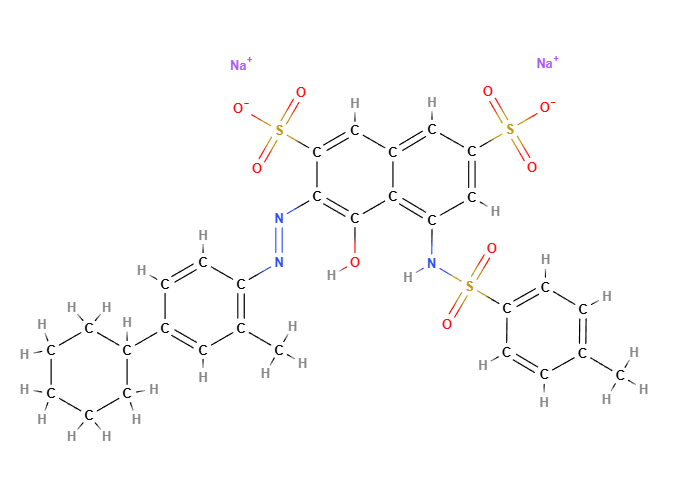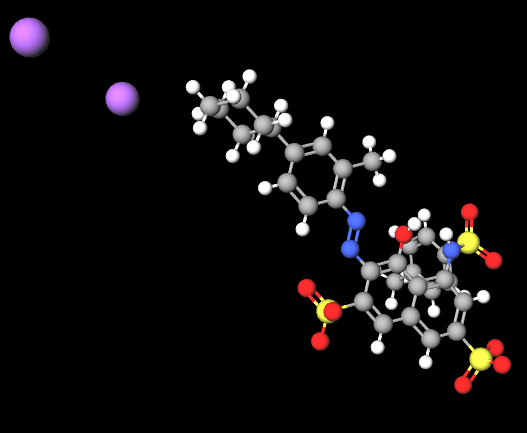| "Descrizione" by admin (19549 pt) | 2024-May-23 09:32 |
Acid red 155 is a chemical compound, a monoazo synthetic red dye also known by the name CI 18130
Chemical Name:
2,7-Naphthalenedisulfonic acid, 3-((4-cyclohexyl-2-methylphenyl)azo)-4-hydroxy-5-(((4-methylphenyl)sulfonyl)amino)-,disodium salt
What it is used for and where
Cosmetics
Restricted cosmetic ingredient as IV/39 a Relevant Item in the Annexes of the European Cosmetics Regulation 1223/2009. Substance or ingredient reported: 2,7-Naphthalenedisulfonic acid, 3-((4-cyclohexyl-2-methylphenyl)azo)-4-hydroxy-5-(((4-methylphenyl)sulfonyl)amino)-, disodium salt
Colorant. This ingredient has the function of colouring the solution in which it is inserted in a temporary, semi-permanent or permanent manner, either alone or in the presence of the complementary components added for colouring.
Safety
It is an ingredient that makes the final product more attractive from an aesthetic point of view, but can pose a potential health risk with undesirable side effects especially when used continuously as it can be absorbed through the skin or mucous membranes.
The problem associated with azo dyes (monoazo or diazo) is photocatalytic degradation leading to eventual oxidation and subsequent formation of impurities such as aromatic amines some of which have carcinogenic activity (1).
It is an ingredient that has some important health-related contraindications: it should only be used in cosmetic products that have contact with the skin for a short time.
 |  |
Molecular Formula C30H32N3NaO9S3
Molecular Weight 717.7 g/mol
CAS 8004-53-3 10236-37-0
UNII
EC Number 616-834-9
Synonyms:
CI 18130
Supranol brilliant red 3B
References________________________________________________________________________
(1) Chung KT, Stevens SE Jr, Cerniglia CE. The reduction of azo dyes by the intestinal microflora. Crit Rev Microbiol. 1992;18(3):175-90. doi: 10.3109/10408419209114557.
Abstract. Azo dyes are widely used in the textile, printing, paper manufacturing, pharmaceutical, and food industries and also in research laboratories. When these compounds either inadvertently or by design enter the body through ingestion, they are metabolized to aromatic amines by intestinal microorganisms. Reductive enzymes in the liver can also catalyze the reductive cleavage of the azo linkage to produce aromatic amines. However, evidence indicates that the intestinal microbial azoreductase may be more important than the liver enzymes in azo reduction. In this article, we examine the significance of the capacity of intestinal bacteria to reduce azo dyes and the conditions of azo reduction. Many azo dyes, such as Acid Yellow, Amaranth, Azodisalicylate, Chicago Sky Blue, Congo Red, Direct Black 38, Direct Blue 6, Direct Blue 15, Direct Brown 95, Fast Yellow, Lithol Red, Methyl Orange, Methyl Red, Methyl Yellow, Naphthalene Fast Orange 2G, Neoprontosil, New Coccine, Orange II, Phenylazo-2-naphthol, Ponceau 3R, Ponceau SX, Red 2G, Red 10B, Salicylazosulphapyridine, Sunset Yellow, Tartrazine, and Trypan Blue, are included in this article. A wide variety of anaerobic bacteria isolated from caecal or fecal contents from experimental animals and humans have the ability to cleave the azo linkage(s) to produce aromatic amines. Azoreductase(s) catalyze these reactions and have been found to be oxygen sensitive and to require flavins for optimal activity. The azoreductase activity in a variety of intestinal preparations was affected by various dietary factors such as cellulose, proteins, fibers, antibiotics, or supplementation with live cultures of lactobacilli.
| Evaluate |

